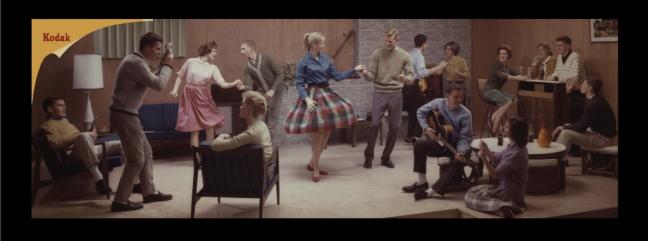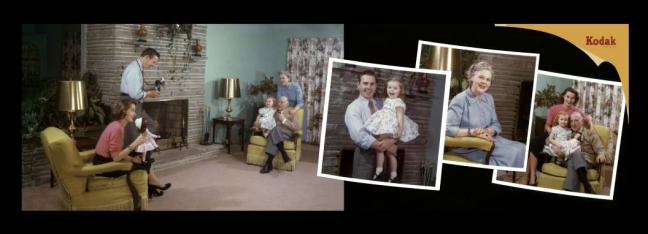Curated by François Cheval, Caroline Lossent, Gilles Mora
Prints : museum Nicéphore Niépce laboratory on Canson Infinity Photosatin premium RC 270g
Exhibition co-produced with the Pavillon populaire, espace d’art photographique de la Ville de Montpellier, with the support of the Ministry of culture – DRAC Bourgogne Franche-Comté and the Friends of the Nicéphore Niépce museum Acknowledgement: Kodak France The George Eastman House, Rochester, USA CECIL (Cercle des conservateurs de l’image latente)
Coloramas, panoramic images in exceptional dimensions were used as early as 1950 to promote the Kodak brand. These 18 metre prints were posted in Grand Central Station in New York and quickly became known as the biggest photographs in the world. They promoted the brand’s cameras and remain the most obvious expression of the post-war American dream with their spectacular, almost surreal scenes.
From 1950 to 1990, the American firm Kodak produced Coloramas : panoramic images that were coloured and printed in monumental sizes (18 metres wide and 5.5 metres high). These brightly coloured, back-lit transparencies were installed in New York City’s Grand Central Terminal. They were replaced every three weeks and became a veritable visual rendezvous for passengers, inspiring much excitement and comment.
These exceptional advertisements went beyond the promotion of Kodak cameras, they depicted a version of a perfect life immortalised by photography. The complex process was entrusted to a few well-known photographers (Ansel Adams, Eliot Porter, Ernst Haas), and mainly to the company’s in-house photographers.
The creation of the panorama proved to be particularly complex. The Colorama was 18 metres wide and 5.5 metres high and each stage of the manufacturing process required the resolution of unprecedented issues, so it was quite an achievement. All of the proportions were off the charts. The complex question of optics was compounded by the limitations of Ektacolor . Traditional panoramic cameras designed for landscapes were adapted and tinkered with by the technicians at Kodak. The developing process required a specific enlarger made at the main factory in Rochester. The whole operation took sixteen hours! The retouching phase was also vast. Faults over a 100 m² space had to be corrected. The final image was made from 41 strips of positive transparencies.
Much more than a panorama, the Colorama was a form of mass entertainment and a monument to fifties optimism. Viewers saw themselves or wished they could see themselves inside this appearance of harmony, these scenes of timeless and endless happiness, where the sky was always blue, nature was always vast and unspoilt, where the family was always together, surrounded by objects that provided well-being and fulfilment.
Taking its lead from the American Dream, the Colorama affirmed a certain model and the values that went with it: those of the new consumer society.
Each image regurgitated the values of white, Anglo-Saxon, materialistic and patriotic American society, the pioneering myth. It wasn’t until 1967 that African Americans were to appear. The Coloramas were not there to bear witness to American society, but to create an image of serenity that would incite people to buy Kodak products. The naive, fake feel to these scenes was obvious, even appreciated as it provided a break from everyday worries. Just like an episode of a television series, each Colorama was the equivalent of another, the one before and the one after. Featuring a confident materialism and a certain American way of Life, it contributed to the elaboration of a benevolent frame of reference, and the constitution of the collective unconscious. Taking its lead from the American Dream, the Colorama affirmed a certain model and the values that went with it: those of the new consumer society.
Each of the 565 Coloramas produced over a forty-year period was a one-off, and they were all destroyed after use. The prints in this exhibition were made in our museum laboratory, from film from the fifties to the seventies preserved in its collections, in order to carefully reproduce the American firm’s visual marketing.
Publications :
La vie en Kodak
Colorama publicitaires des années 1950 à 1970
Texts : François Cheval and Gilles Mora
Editions Hazan
146 pages
2015
ISBN : 9782754108188









